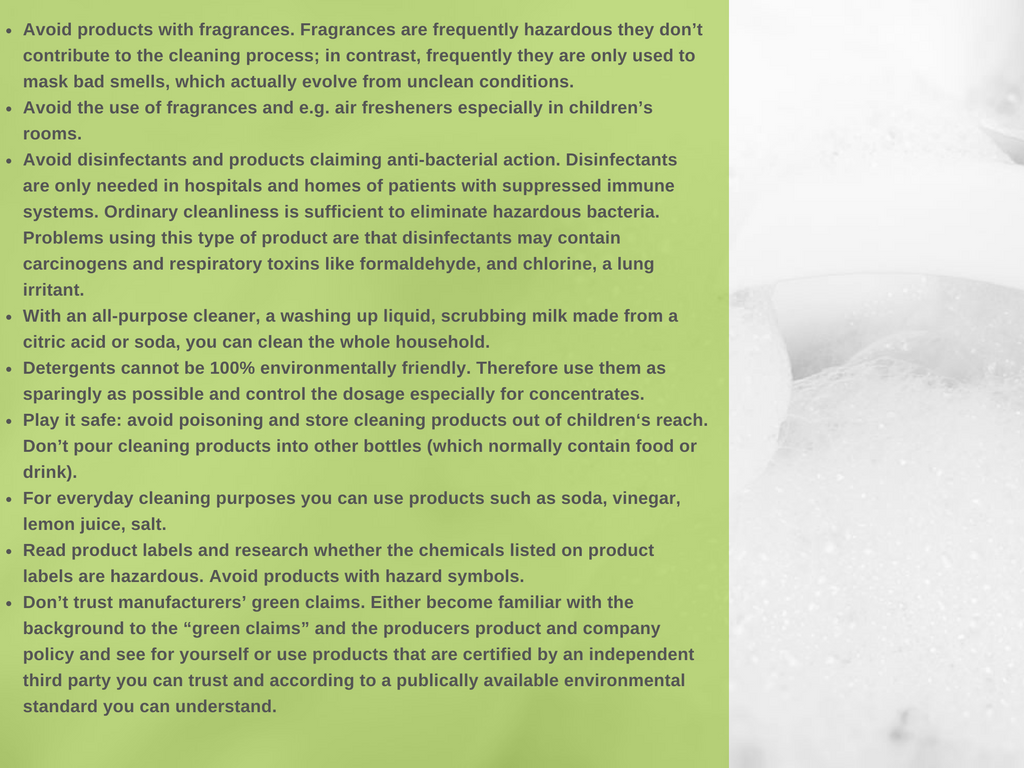Do we really need so many cleaning agents?
The problem
Many chemicals contained in cleaning products are corrosive, can irritate your skin and respiratory system and may cause allergies. Poison centers report that the majority of cases of human exposure to hazardous chemicals/intoxication is related to cleaning products. These cases of acute intoxication frequently involve children under six-years of age, who have accidentally swallowed or spilled cleaners.
Using different household cleaning products in your home can lead to high short-term levels of chemicals in the indoor air which may even be higher than the outdoor air in polluted cities.
In addition, many scientists are now becoming concerned that long-term low-level exposure to a cocktail of chemicals like the ones found in household air from cleaning products or in dust may put our health at risk. Testing for human health effects is normally done on single chemicals. But in the real world, we are all exposed to a variety of chemicals every single day. You can decrease the risk by choosing safer products. Most cleaning tasks at our homes can easily be handled with everyday, less toxic, common, inexpensive ingredients like baking soda, washing soda, vinegar, salt, lemon juice, vegetable oil, soap, borax and an increasing number of manufacturers are also offering less toxic cleaning products.
When we talk about cleaning products we mean for example all-purpose cleaners, laundry detergents, dishwashing agents, oven sprays, carpet and furniture cleaners, oven sprays, toilet cleaners, scouring agents, glass cleaners and so on.
Most cleaning products contain different chemicals because they fulfil a number of functions IN ADDITION to just clean. Most of these functions are actually not necessary and once you decide to buy a cleaning product ONLY to clean, you may avoid buying many hazardous chemicals already.
- Cleaning: this requires that „dirt” is destroyed or dissolved; for this acids, bases or tensides are used. Acids and bases may cause burns on your skin or irritation to your lungs. Tensides are hazardous to the environment. These substances cannot be fully avoided, if you want to clean, but you can make better choices!
- Disinfectants are used to „remove bacteria” and many of these chemicals have serious health effects (e.g. cause cancer) and all of them damage the environment and can disturb the sewage treatment plant functioning. Actually bacteria are not so dangerous as they appear and it is sufficient just to clean!
- Preservatives are added, so the cleaner does not mold. These substances may have similar effects like disinfectants. If you use your cleaning agents regularly, they are empty long before they could „turn bad”. Preservatives are not necessary.
- Solvents are used to dissolve the substances in the cleaner. They can make you dizzy or cause nausea if they are inhaled for a long time. In the long run some may cause cancer. Products based on water don’t need other solvents; hence their use can also be avoided.
- Fragrances are mixtures of very many substances and many of them can cause allergens or can cause irritation to lungs and skin. If things are clean they shouldn’t smell bad. Fragrances are not needed in addition!
- Optical brighteners are used in washing detergents. They bind to the textile and change the way they look but don’t actually remove dirt. This is an optical trick and these substances are hazardous to the environment. If you want to cheat on the cost of the environment. You decide if you want to cheat on the cost of the environment or if you could avoid the use of hazardous substances.
- Bleaching agents are frequently very aggressive coloring compounds. Inhaling the fumes can damage the mucous membranes; getting it onto skin may cause severe burns. Aggressive bleaching is normally not necessary.
MORE ABOUT FUNCTIONS OF CHEMICALS IN CLEANING PRODUCTS
Tips & tricks

Possible health effects
Cleaning ingredients vary in the type of health hazard they pose. Some cause acute, or immediate, hazards such as skin or respiratory irritation, watery eyes, or chemical burns, while others are associated with chronic, or long-term, effects such as cancer. Besides the health concerns there is also the environmental aspect. When household chemicals are poured down the drains, treated by municipal waste water treatments plants, the treated water ends up being discharged into nearby waterways. Some of these hazardous chemicals are very persistent and do not break down into harmless substances, thereby once released into the water they may have adverse effects on the water quality, fish and other wildlife.
Below is a table explaining the health and environmental effects of some of the hazardous chemicals used in household cleaning products:
Uses
Disinfectants
Preservatives
Hazardous chemicals
Formaldehydes and formaldehyde releasers (e.g. benzylhemiformal, 2-bromo-2-nitropropane-1,3-diol, 5-bromo-5-nitro-1,3-dioxane, diazolidinyl urea, Imidazolidinyl urea, Quaternium-15, DMDM Hydantoin)
Possible health effects
Irritates mucous membranes and skin, can cause hypersensitivity, carcinogenic (nasal pathway)
Used in products
All purpose, laundry, dishes, floor, furniture, air freshener
Uses
Disinfectants
Preservatives
Hazardous chemicals
Triclosan
Possible health effects
Can cause allergies and bacterial resistance; disrupt the endocrine system, very toxic to aquatic life
Used in products
All purpose, bath and toilet, floor, furniture
Uses
Solvents
Hazardous chemicals
1,2-dichlorobenzene
Possible health effects
Very toxic to aquatic organisms, may cause long-term adverse effects in the aquatic environment, irritating
Used in products
All purpose, bath and toilet, air preshener
Uses
Solvents
Hazardous chemicals
2-methoxyethanol, 2-ethoxyethanol
Possible health effects
Impairs fertility, harmful by inhalation, swallowing and skin contact, and for the unborn child
Used in products
All purpose, air freshener
Uses
Solvents
Hazardous chemicals
2-ethoxyethyl acetate
Possible health effects
Impairs fertility, harmful by inhalation, swallowing and skin contact, and for the unborn child
Used in products
Laundry
Uses
Perfumes
Hazardous chemicals
Phthalates
(DEHP, Bis (2-ethylhexylphthalat)
Possible health effects
Disrupts development and the hormone system, impairs fertility
Used in products
Laundry
Uses
Surfactants
Hazardous chemicals
Octamethylcyclo-tetrasiloxane
Possible health effects
Disrupts the hormone system and the fertility
Used in products
All purpose, laundry, dishes
Uses
Surfactants
Hazardous chemicals
Octylphenol (ethoxylates)
Possible health effects
Endocrine disruptor, persistent, accumulates in the environment
Used in products
All purpose, laundry, bath and toilet, floor, furniture

